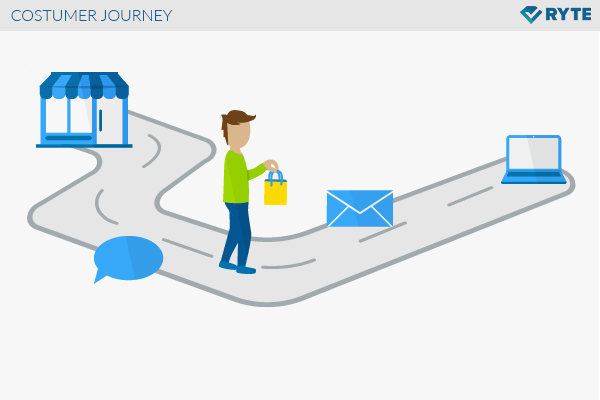Customer Journey
Customer journey refers to the path followed by a customer via so-called touchpoints before making a purchase decision. It can be visualized in a customer journey map.
Definition
The customer journey in marketing refers to the customer’s path, via touchpoints, to their decision to purchase an item. A customer doesn’t usually decide to purchase an item immediately after finding out about it for the first time. Usually, customers look at a product or a brand several times before deciding on an action, known in marketing as touchpoints. The customer journey then proceeds through these touchpoints.
In offline advertising, it is very difficult to map the customer journey, because it is generally impossible to find out where each visitor found about a store, and why they're there. Possible reasons could include recommendation from family or friends, a flyer, or newspaper advertisement. You might be able to find out the reasons with a qualitative survey. However, these surveys are expensive to conduct. New approaches such as "Instore-Tracking" via "Beacons" or wifi-tracking are making it easier for stationary stores to reconstruct the customer journey inside a store.
On the internet, however, the contact points of any potential customers for a product or service can be precisely tracked with suitable tracking tools, even across many channels. What exactly is meant by customer journey is shown in this video.
Example of a customer journey
An amateur gardener discovers a new garden device in an opinion forum, which they find interesting. In a brochure from the local do-it-yourself store, which was included with his newspaper, he finds out some basic data about the product, for example, the technical features and price. His interest intensifies. They search on the Internet for the product and want to read about whether other amateur gardeners may have already reported on experience with the device. They use a rating portal. The experiences from others inspire them, and they want to buy the device. They visit the manufacturer’s website to find out where they can buy it, then they go to one of the specified online shops and order the product.
In this example, there are several touchpoints.
Opinion forum Do-it-yourself store brochure in the newspaper Rating portal on the Internet Manufacturer’s website Online Shop of an authorized dealer
Touchpoints
There are many different types of media that can be considered interaction and contact points. There is offline advertising media such as TV ads, radio spots, newspaper inserts and ads on billboards. However, these forms of advertising cannot be tracked. Online touchpoints are more interesting for online marketing, such as blogs, manufacturer sites, banner ads, opinion forums or experience portals. They can be made fully visible in the form of customer journeys.
Phases of the customer journey
There are different approaches in terms of how to divide the phases of the customer journey. However, they all share one idea in common; it can be assumed that the decision to buy is not usually made immediately. First, the target group must be made aware of the product. In the next step, interest for the product must be created. Only some time after information was received will a desire for the product arise, which eventually ideally leads to action. One speaks in this case of a conversion. The principle is similar to the AIDA model.
The envisioned action does not necessarily have to be a purchase or order. Even the registration for an email newsletter or requests for information can be a reasonable goal, depending on the individual corporate objectives.
Purpose of the customer journey
The purpose of evaluating and mapping the customer journey is to find out more about consumer behavior. The customer journey can therefore be better designed, leading to an increase in the conversion rate. The relationship between different touchpoints can also be analyzed.
Customer journey analysis
Tracking tools, such as cross-domain tracking or cross-device tracking can help in the analysis or mapping of the customer journey. Cross-device tracking is a particularly useful tool for gaining insights into the customer journey, as this makes it possible to find out what device the potential customer used to access the site, and in what order.
Problems
Depending on the data available, it may be difficult to find out exactly which touchpoint led to a conversion. Every touchpoint usually contributes to some extend to the customer’s purchase decision. If the consumer hadn't become aware of the product at the first touchpoint, they may never have found out about it at all. Every touchpoint contributes to an extent to the final conversion. Read more about attribution modeling here.
The analysis of the customer journey can cause problems in online marketing due to data protection. The customer journey cannot be precisely reconstructed if a user deletes their cookies or uses a tool that prevents tracking, and the combination of different data is only allowed in certain circumstances.

